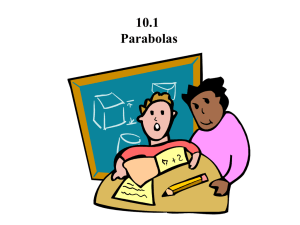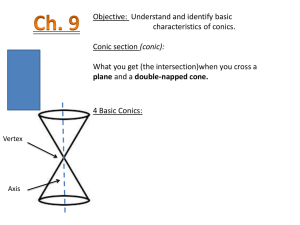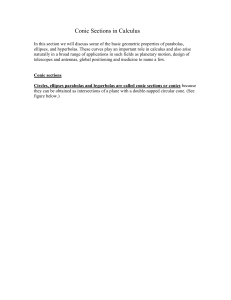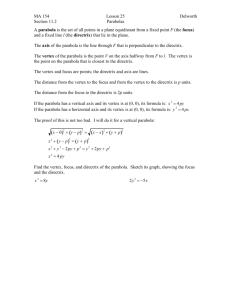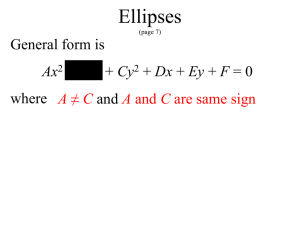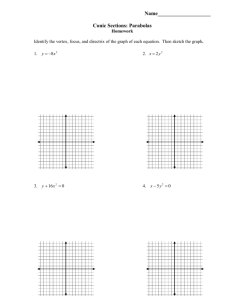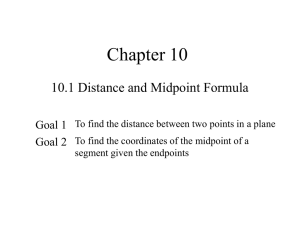Chapter 11
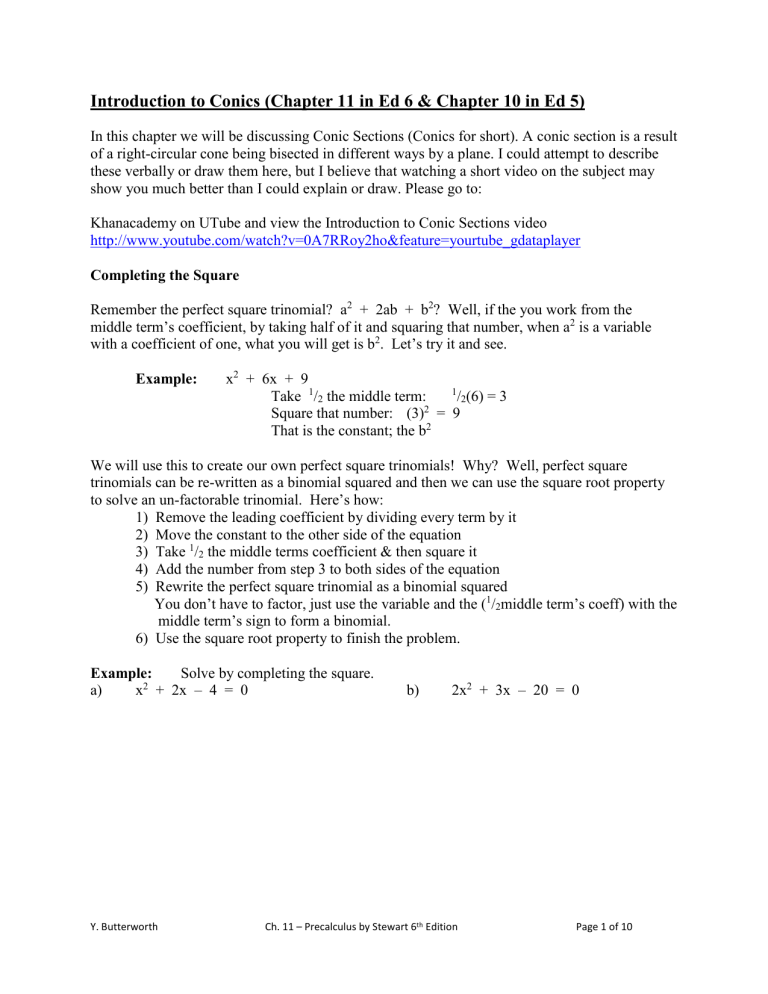
Introduction to Conics (Chapter 11 in Ed 6 & Chapter 10 in Ed 5)
In this chapter we will be discussing Conic Sections (Conics for short). A conic section is a result of a right-circular cone being bisected in different ways by a plane. I could attempt to describe these verbally or draw them here, but I believe that watching a short video on the subject may show you much better than I could explain or draw. Please go to:
Khanacademy on UTube and view the Introduction to Conic Sections video http://www.youtube.com/watch?v=0A7RRoy2ho&feature=yourtube_gdataplayer
Completing the Square
Remember the perfect square trinomial? a
2
+ 2ab + b
2
? Well, if the you work from the middle term’s coefficient, by taking half of it and squaring that number, when a 2
is a variable with a coefficient of one, what you will get is b
2 . Let’s try it and see.
Example: x
2
+ 6x + 9
Take 1 /
2
the middle term: 1 /
2
(6) = 3
Square that number: (3)
2
= 9
That is the constant; the b
2
We will use this to create our own perfect square trinomials! Why? Well, perfect square trinomials can be re-written as a binomial squared and then we can use the square root property to solve an un-factorable trinomial. Here’s how:
1) Remove the leading coefficient by dividing every term by it
2) Move the constant to the other side of the equation
3) Take
1
/
2
the middle terms coefficient & then square it
4) Add the number from step 3 to both sides of the equation
5) Rewrite the perfect square trinomial as a binomial squared
You don’t have to factor, just use the variable and the (
1
/
2 middle term’s coeff) with the
middle term’s sign to form a binomial.
6) Use the square root property to finish the problem.
Example: Solve by completing the square. a) x
2
+ 2x – 4 = 0 b) 2x
2
+ 3x – 20 = 0
Y. Butterworth Ch. 11 – Precalculus by Stewart 6 th Edition Page 1 of 10
§11.1 Parabolas (§10.1 in Ed 5)
We already know what a parabola looks like and two forms of the parabolas equation as well as some key features & how to graph those key features from Intermediate Algebra. Now, we need to expand our knowledge to include another form of the equation and some more key features. In this section and each that follow I will briefly outline the key features and how to get them, then discuss the equations for the two orientations of the conic and then give some examples. All conics in §11.1-11.3
Faces Up/Down
(Along the vertical axis)
Faces Left/Right
(Along the horizontal axis)
Vertex
Axis of Symmetry
(0, 0) x = 0
(0, 0) y = 0
Directrix y = –p x = –p
A line perpendicular to the axis of symmetry p units under/over or right/left of the vertex. This line does not cut the parabola.
Focus (0, p) (p, 0)
Latus Rectum | 4p | | 4p |
This is a line segment from one side of the parabola to the other through the focus. The distance from the focus to the parabola is | 2p |. This is also called the focal length of the parabola p p > 0 opens up p < 0 opens down
This is the distance from the focus to the vertex and from the vertex to the directrix p > 0 opens right p < 0 opens left
Directrix Form of a Parabola (Along the Vertical Axis) x 2 = 4py
Directrix Form of a Parabola (Along the Horizontal Axis) y
2
= 4px
Using the Directrix Form
1) Notice there is no constant
2) Solve for the squared variable
3) Set numeric coefficient of the resulting 1 st degreed term equal to 4p
4) Solve for p so you can give a) Focus as (0, p) or (p, 0) b) Directrix as x = -p or y = -p
5) Get two points on the line horizontal/vertical to the focus that are 2p units away from the foci (these are on the parabola)
Note: On a graphing calculator you must graph a parabola using the positive and negative roots from the form found in 2) above.
Y. Butterworth Ch. 11 – Precalculus by Stewart 6 th Edition Page 2 of 10
What is the benefit of knowing the Focus of a parabola?
Application in light and sound
If a source is placed at the focus of a parabola the waves are reflected off the parabola parallel to the axis of symmetry.
This is why mirrors in lenses and telescopes are parabolic.
Example: For the two equations below put them in directrix form and then a) b)
Find the focus
Find the Directrix c) Find the focal diameter & use it to find 2 points on the parabola d) Sketch the parabola with these key features
1) 8x 2 + 12y = 0 2) 5x + 3y 2 = 0
§11.4 Shifted Conics (The Parabola Portion)
In order to work with shifted conics you will have to review completing the square. I have included this review on the first page of this hand out.
Shifted conics don’t have a vertex/center at the origin. They are shift vertically and/or horizontally from the origin so we will need to get the squared variable and it’s 1 st
degree term separate from the other terms and complete the square. Once we have completed the square we will see our parabola in one of the following forms:
Faces Up/Down
(Along the vertical axis)
Vertex (h, k)
Faces Left/Right
(Along the horizontal axis)
(h, k)
Axis of Symmetry x = h y = k
Directrix y = k – p x = h – p
A line perpendicular to the axis of symmetry p units under/over or right/left of the vertex. This line does not cut the parabola.
Focus (h, k + p) (h + p, k)
Latus Rectum | 4p | | 4p |
Y. Butterworth Ch. 11 – Precalculus by Stewart 6 th Edition Page 3 of 10
This is a line segment from one side of the parabola to the other through the focus. The distance from the focus to the parabola is | 2p |. This is also called the focal length of the parabola p p > 0 opens up p < 0 opens down
This is the distance from the focus to the vertex and from the vertex to the directrix p > 0 opens right p < 0 opens left
Directrix Form of a Shifted Parabola (Along the Vertical Axis)
(x – h)
2
= 4p(y – k)
Directrix Form of a Shifted Parabola (Along the Horizontal Axis)
(y – k)
2
= 4p(x – h)
Example: Put each quadratic into Directrix Form with shifts & find a) Open up/down or right/left
1) y 2 + 10y = -6x – 13
2) x 2 + 6x + 12y = 9 b) c) d)
Vertex
Focus
Directrix e) Sketch a graph
Y. Butterworth Ch. 11 – Precalculus by Stewart 6 th Edition Page 4 of 10
§11.2 Ellipses (§10.2 in Edition 5)
An ellipse can be described as an “egg-shaped” circle created by attaching a string to 2 points on a line and rotating through one revolution. In fact a circle is a special circumstance of a an ellipse.
Major Axis the horizontal axis Major Axis the vertical axis
Center (0, 0) (0, 0)
Vertex
Focus c 2 = a 2 – b 2
(a, 0)
(c, 0)
(-a, 0)
(-c, 0)
(0, a)
(0, c)
(0, -a)
(0, -c)
Major Axis 2a
This is a line segment from one vertex to the other through the foci.
Minor Axis 2b
This is a line segment from one side of the ellipse to the other through the center.
Eccentricity e = c / a
0 < e < 1
*Closer to 0 is a more circle like
Ellipse with Major Axis Along the Horizontal Axis
x
2
+ y
2
= 1
a
2
b
2
Ellipse with Major Axis Along the Vertical Axis
x
2
+ y
2
= 1
b
2
a
2
2a
2b e = c / a
An ellipse isn’t always in the above form and sometimes we will need to get the x 2 and y 2 separate from the constant and then make the constant one by dividing all terms by the constant.
Furthermore, sometimes there isn’t a visible a 2
or b
2
and we will have to rewrite a numeric coefficient as division by a reciprocal to “get” a 2 or b 2 .
Example: Put each into the above form & indicate if the major axis will be along the vertical or horizontal axis. a) 4x
2
+ y
2
= 1 b) 9x
2
+ 4y
2
= 1
Y. Butterworth Ch. 11 – Precalculus by Stewart 6 th Edition Page 5 of 10
Example: For each of the equations find the following
1) 4x 2 + y 2 = 16
2) 4x 2 + 25y 2 = 100 a) b) c) d) e) f)
Vertices
Foci
Eccentricity
Length of the major axis
Length of the minor axis
Sketch a graph
Applications of Ellipses
Again sound & light is where we find applications. Waves emanating from one foci of an ellipse are focused to the other foci by the ellipse.
An example is the Mormon Tabernacle. If a pin is dropped at the foci that is center stage, it can be heard in the foci at the back of the Tabernacle.
§11.4 Shifted Ellipses (§10.4 in Ed 5)
Just as with the parabola, we can shift the ellipse from the origin in the horizontal and/or vertical direction. You will again need your completing the square skills, not just once but possibly twice to put an ellipse into the form
Major Axis the horizontal axis Major Axis the vertical axis
Center
Vertex
(h, k)
(h + a, k) (h – a, k)
(h, k)
(h, a + k) (h, k – a)
Focus c 2 = a 2 – b 2
(c + h, k) (h – c, k)
Major Axis 2a
This is a line segment from one vertex to the other through the foci.
Minor Axis 2b
This is a line segment from one side of the ellipse to the other through the center.
Eccentricity e = c / a
0 < e < 1
*Closer to 0 is a more circle like
(h, c + k)
2a
2b e = c / a
(h, k – c)
Y. Butterworth Ch. 11 – Precalculus by Stewart 6 th Edition Page 6 of 10
Major Axis is Horizontal
(x – h)
2
+ (y – k)
2
= 1
a 2 b 2
Note: a > b; that’s what makes the distinction between the a & the b!
Major Axis is Vertical
(x – h)
2
b 2
+ (y – k)
2
a 2
= 1
Example: Put each ellipse into “Center” form a) 9x
2
– 36x + 4y
2
= 0 b) 9y
2
– 36y + 24 = -4(x
2
+ 9)
Example: Now using the last example, find the following for each equation a) Center b) Foci c) Vertices d) Eccentricity e) Length of the Major Axis f) Length of the Minor Axis g) Sketch the graph
Y. Butterworth Ch. 11 – Precalculus by Stewart 6 th Edition Page 7 of 10
§11.3 Hyperbolas (§10.3 in Ed 5)
A Hyperbola is like a parabola and its reflections across a directrix like line.
Opens Left & Right Opens Up & Down
Center (0, 0)
Vertices (a, 0) (-a, 0)
Transverse Axis Horizontal : 2a
A line between the vertices through the center
Asymptotes y = b
/ a
x and y = – b
/ a
x
Foci c 2 = a 2 + b 2 in this case
(c, 0) (-c, 0)
Central Box Box thru vertices &
Between “parabolas” (a, b), (a, -b), (-a, b) (-a, -b)
(0, a)
(0, 0)
Vertical : 2a
(0, -a) y = a
/ b
x and y = – a
/ b
x
(0, c) (0, -c)
Box thru vertices &
(b, a), (b, -a), (-b, a), (-b, -a)
Equation for a Left/Right Hyperbola
x
2
– y
2
= 1 a, b > 0
a
2
b
2
Equation for an Up/Down Hyperbola
y
2
– x
2
= 1 a, b > 0
a 2 b 2
Example:
1) x
2
– y
2
= 1
For each of the following find
9 16
2) 9x 2 – 4y 2 = 36 a) b) c) d) e)
Opens Up/Down or Left/Right
Vertices
Foci
Asymptotes
Sketch a graph with the central box
Application of Hyperbolas
Focusing Light
Locating Objects (an old version of GPS called LORAN)
Y. Butterworth Ch. 11 – Precalculus by Stewart 6 th Edition Page 8 of 10
§11.4 Shifts for Hyperbolas
We will need to complete the square again up to two times to see the formula of a hyperboal in this section too.
Left/Right Opening Shifted Hyperbola
(x – h)
2
– (y – k)
2
= 1
a 2 b 2
Up/Down Opening Shifter Hyperbola
(y – k)
2
– (x – h)
2
= 1
a
2
b
2
Opens Left & Right Opens Up & Down
Center
Vertices
(h, k)
(h+a, k) (h–a, k)
Transverse Axis Horizontal : 2a
A line between the vertices through the center
(h, k)
(h, a+k)
Vertical : 2a
(h, k–a)
Asymptotes y – k = b
/ a
(x – h) and y – k = – b
/ a
(x – h) y – k = a
/ b
(x – h) and y – k = – a
/ b
(x – h)
(h+c, k) (h–c, k) (h, c+k) (h, k–c) Foci c 2 = a 2 + b 2 in this case
Central Box Box thru vertices & asymptote
Between “parabolas” (a+h, b+k), (a+h, k-b),
Box thru vertices & asymptote
(b+h, a+k), (b+h, k-a),
(h-a, k+b) (h-a, k-b) (h-b, a+k), (h-b, k-a)
Example: Find the following for a) b)
Direction of opening
Center c) Vertices d) Foci e) f)
Asymptotes
Sketch with the central box x 2 – y 2 = 10(x – y) + 1
Some closing remarks:
1) Not every conic can be categorized into parabola, ellipse and hyperbolas. Some are degenerate .
2) When looking at a bunch of conic equations and trying to decide which is which look at
1)
Are both x & y’s squared
Y. Butterworth Ch. 11 – Precalculus by Stewart 6 th Edition Page 9 of 10
a)
No then it’s a parabola b) Yes the ellipse or hyperbola
2) Both x’s & y’s are square look at signs (after x’s & y’s separated from constant) a) Both are positive & so is constant then they are ellipses b) Constant & one variable are the same sign and other variable is opposite then hyperbola c) d)
Both variables are negative & constant is positive or both variables are positive & constant is negative then it is degenerate
Constant is zero—degenerate
Example: Can you tell which is a hyperbola, an ellipse, a parabola and degenerate? a) 4x
2
+ 9y
2
– 36y = 0 b) 4x 2 – 4x – 8y + 9 = 0 c) x
2
+ 4y
2
+ 20x = 40y – 300 d)
3
/
16
y
2
+ 1 = x(x – 8) + 4
4
Y. Butterworth Ch. 11 – Precalculus by Stewart 6 th Edition Page 10 of 10
